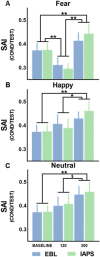Sensorimotor inhibition during emotional processing
- PMID: 35488018
- PMCID: PMC9054825
- DOI: 10.1038/s41598-022-10981-8
Sensorimotor inhibition during emotional processing
Abstract
Visual processing of emotional stimuli has been shown to engage complex cortical and subcortical networks, but it is still unclear how it affects sensorimotor integration processes. To fill this gap, here, we used a TMS protocol named short-latency afferent inhibition (SAI), capturing sensorimotor interactions, while healthy participants were observing emotional body language (EBL) and International Affective Picture System (IAPS) stimuli. Participants were presented with emotional (fear- and happiness-related) or non-emotional (neutral) EBL and IAPS stimuli while SAI was tested at 120 ms and 300 ms after pictures presentation. At the earlier time point (120 ms), we found that fear-related EBL and IAPS stimuli selectively enhanced SAI as indexed by the greater inhibitory effect of somatosensory afferents on motor excitability. Larger early SAI enhancement was associated with lower scores at the Behavioural Inhibition Scale (BIS). At the later time point (300 ms), we found a generalized SAI decrease for all kind of stimuli (fear, happiness or neutral). Because the SAI index reflects integrative activity of cholinergic sensorimotor circuits, our findings suggest greater sensitivity of such circuits during early (120 ms) processing of threat-related information. Moreover, the correlation with BIS score may suggest increased attention and sensory vigilance in participants with greater anxiety-related dispositions. In conclusion, the results of this study show that sensorimotor inhibition is rapidly enhanced while processing threatening stimuli and that SAI protocol might be a valuable option in evaluating emotional-motor interactions in physiological and pathological conditions.
© 2022. The Author(s).
Conflict of interest statement
The authors declare no competing interests.
Figures




References
Publication types
MeSH terms
LinkOut - more resources
Full Text Sources
Miscellaneous

